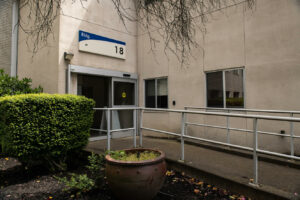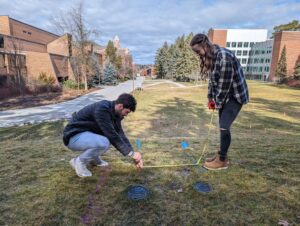PULLMAN, Wash. (Murrow News 8) – He’s been called a genius. Some say hardly challenged by his position as a track coach.
Spending 21 years at the helm of Washington State University’s program, John Chaplin totaled a 202-15 dual meet record, six national dual meet titles, and the school’s lone NCAA Championship in 1977.
“When I was there, we had 18 Olympians, world record holders, and gold medalists,” former WSU track athlete (‘83-‘88) Kris Durr Sr. said. “It was amazing.”
Former WSU Athletic News Manager (’57-‘70) Dick Fry credits Chaplin for putting Wazzu on the national track map, and he’s far from alone.
“We would travel the country and people would see WSU – simple letters – and we would get pointed at,” Durr Sr. said. “People knew who we were.”
An ironic story arc, though, for a man who doesn’t even like running.
“Ohh no! I despise running,” Chaplin said. “Swimming, or any other kind of physical exercise.”
There’s a lot of nuance to Chaplin. His life is a story laced with turns. And his path to Washington State begins with a lost boy from Los Angeles taking the wrong one and nearly missing town.
“There wasn’t a sign!” Chaplin said. “I said ‘oh my heavens. I think that was it.’”
Promptly turning around, he found the nearest gas station.
“Do you know where Pullman is?” he asked.
“You’re in it,” the employee responded.
Pullman didn’t have sufficient signs in the 60’s according to Mayor Glenn Johnson. A problem he’s happy to report has been remedied.
John was on scholarship running track for the Cougs. He’d never been to Pullman and admits he couldn’t show you where it was on a map before making the trip. But he found his way.
Under legendary head coach Jack Mooberry, John was a force running four different events. His success holding so much gravity, Mooberry instructed the grounds crew to paint the track specifically to Chaplin’s liking.
The track was converted from 800 meters down to the standards 400-meter length. A straightaway strip was kept for the 200 meter race, but Chaplin demanded he run it around the curve.
“You don’t understand, John,” the groundskeeper told him. “It’s harder to paint the corners.”
“Yeah, but those guys in 200 meter are going to be fresh, and I’m better around the curve,” Chaplin said.
But by 1963, it was time for Chaplin to graduate. He broke two world records as a team captain thinking he’d left the sport behind him. He aspired to work in Law, but not before a brief stint at Oregon State for a master’s degree.
However, a graduate assistant position opened with the Beavers. Old habits die hard goes the saying.
“I said if I could be a full-time assistant track coach, I’d do it thinking he was gonna say no,” Chaplin said. “He said yes.”
Oregon State doubled his salary, gave him a car, and offered a membership at the local country club.
John worked all day recording stats, doing research, and creating the program’s first pressbook all while being a student himself. But that orange never looked good on anyone and Washington State was like an old love you just can’t help shake.
Right on que, Jack Mooberry called. This time, he needed an assistant.
“I told him I had some good names. But he said ‘no, the only person I want is you.’”
Chaplin froze. Not unreasonable to assume for the first time in his life, falling silent.
A hard bargain to reel Chaplin back to the Palouse, Mooberry created a new position on his staff – the head cross country coach.
“It was the only way he could get me more money,” Chaplin said.
He ran with it.
“He was so well rounded both athletically and academically. He just appealed to so many athletes,” Fry said.
Mooberry retired by 1974 making it Chaplin’s program. He quickly saw an opportunity recruiting international talent.
“At that time it wasn’t really done a ton,” former WSU track athlete (’93-’94) Luke Syverson said. “He pioneered that in track and field for the NCAA.”
Chaplin hung flags along the track representing all 31 countries on WSU’s track team.
“Some of the other track coaches in the Pac-10 didn’t take kindly to that in some ways.” Johnson said.
After catching flak at the conference championship one year, Chaplin responded by showing up to the track next morning in a safari hat former WSU track athlete (’75-’78) Brad Carpenter recalls.
“I helped my buddy coach one of the high school track teams [in Oakland] and Gary Payton was on that team,” Carpenter said. “I always said Gary Payton could trash talk about as good as John Chaplin.”
The Cougs were good under their new head man. So good, they didn’t just try to break world records, they waited until coach Chaplin said they were allowed to.
In 1978, Kenyan star Henry Rono was eyeing down the 3000m steeplechase. Headed into a Eugene for a dual with the Ducks, Chaplin had to intervene.
The pit was illegal according to Chaplin; it wasn’t deep enough. He feared Rono would be stripped of his record with negative press to follow.
“I knew that was the call. I could see story. I could write it myself,” Chaplin added. “I told him he will break it up in Seattle.”
Rono did. But not before Chapin fought off the TrackTown USA’s press and fanbase alike.
“It was a big deal, I mean those rivalries were huge,” Syverson said. “They would televise live the dual meet, WSU and Oregon.”
“I’m not sure I ever lost to a Husky individually,” Durr Sr. said.
Rono set two more world records within the following months. That alone has Chaplin asking for a statue in his honor.
But contrary to his record, it wasn’t all about winning- one could even argue it never was. Academics came first for coach.
In 1993, Kenyan star Josephat Kapkory had to take a test to become a certified Chemical Engineer that was only offered once a year. It conflicted with a dual meet against Cal Berkley.
“If he doesn’t take it now he will have to wait til next year. He’ll be home in Kenya somewhere where he has to make arrangements to find a test and come back to the United States to do it,” Chaplin said. “We don’t want that to happen.”
“It’s just so different from the way coaches are today and how programs are ran,” sports editor at the Bonner County Daily Bee Dylan Greene said.
It was the only meet WSU lost that year. A one-point deficit as Chaplin recalls.
“A few kids lost a ring, yeah,” Chaplin said. “But I don’t think there is one of them to this day who doesn’t think what they did was right.”
Opinionated and outspoken, Chaplin worked in the university’s admissions office for the university. He vocally pushed back on admission standards that disproportionately impacted people of color. Johnson recalls him giving a presentation to university faculty in an effort to be heard and make tangible change on these issues.
“If he sees some injustice in some way, he’s going to fight for that student. And he did,” Johnson said.
“Didn’t matter if you were the last guy on the discus throwing team or the fastest guy breaking records,” Carpenter said. “He did care about everybody. He was a genuine guy.”
The record shows a man of his word. So much so, Chaplin has become a clergyman of the sport. During the 2000 Olympic head coach nominations, his name was called. And a process that typically takes two hours lasted no more than a handful of minutes.
Chaplin received 27 of the 31 votes and went on the coach the Sydney Games.
“He was the most powerful man in track and field,” Durr Sr. said.
But what he’s most proud of, you won’t find on the walls of his study. It’s not sewn on the pocket of his jacket. Or wrapped around one’s neck on a podium.
Chaplin graduated 97 percent of his team with the Cougars.
No, he doesn’t rest on his laurels. But these days, the old coach does take time to himself. A collector, a reader, and fisherman alike.
“I do what I want to,” Chaplin said.
Still no wisdom lost, he offers advice. The same advice given to every one of the 83 All-Americans brought up under his wing.
“Your greatest asset is also your greatest liability,” Chaplin said.
While he waits on that statue of Rono, a formal memorial equally begs his namesake.
“That international connection has been well seen over the years not necessarily just in track athletes but also the way we recruit international students,” Johnson said. “John had a tremendous impact on that. And there ought to be a way that [the university] can memorialize him.”
Because today, it’s just a sidewalk square on Main Street, a cubby in his Fraternity’s trophy case, and a few headlines in the paper.
Unexplainably, that’s all that’s been done to memorialize this Cougar great.















